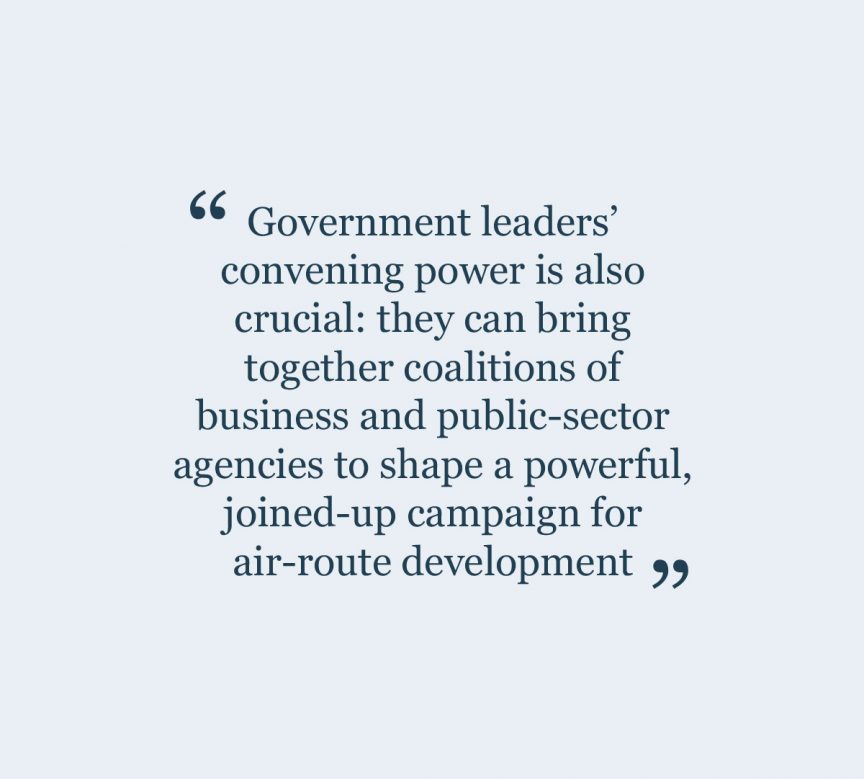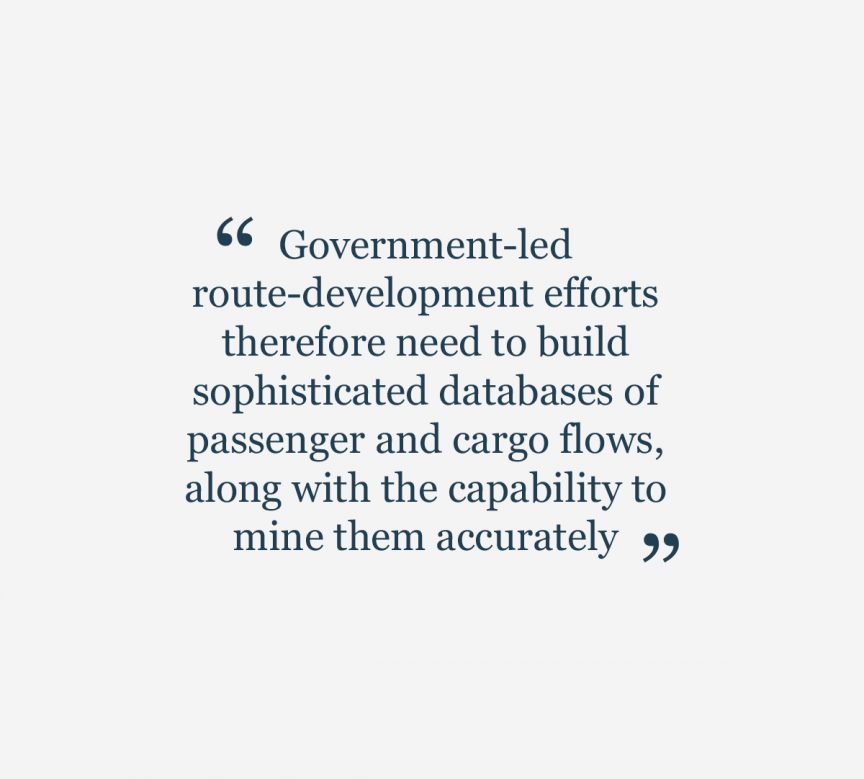Piloting a new route to prosperity:
How government leaders can drive economic take-off through air-route development
By Jean-Marc Bourreau
and Tim Harris
Air-route attraction strategies are too important to leave to airports alone
In Cape Town today, Americans are everywhere. On the beaches, at the mountainside vineyards, in the co-working spaces – South Africa’s premier tourist city and start-up hub has become a go-to destination for US visitors. But it wasn’t always so. Before 2019, every American visiting the city had to travel via a connecting hub on a 20+ hour routing, which kept a lid on demand – simply because getting there was so taxing. That was the year United Airlines launched their non-stop service from New York, after the regional government led a collaboration with business leaders to make the case for the route. It was soon joined by Delta: today, the two carriers provide 13 weekly services to Cape Town from three US cities.
The thousands of Americans landing in Cape Town each week are not only boosting the jobs-rich tourism economy of the city and the surrounding Western Cape region – they are also bringing major business investment. Amazon is constructing a $300 million African headquarters there, and companies like Airbnb and Pepsico are building out their African operations from Cape Town.
None of this has happened by chance. The Premier (Governor) of the Western Cape, Alan Winde, has made attracting direct flights into Cape Town a key part of his strategy to grow the regional economy, attract investment and create jobs. He personally launched an Air Access initiative in 2016 – co-funded and supported by local business leaders and the city’s airport – that landed direct flights from 13 global airlines in just three years.
“ It’s time for government leaders
to climb into the cockpit,
and chart a course of air-route driven
economic take-off ”
Alan Winde is not the only government leader who has had the vision to see air-route attraction as a way to boost the fortunes of his economy. Across the world in Costa Rica, then-Minister of Tourism Carlos Ricardo Benavides led a structured, collaborative effort that attracted 60+ direct flights from US and European cities over the course of a decade – and established the country as one of the most successful tourist markets in the world.
Costa Rica’s strategy focused on attracting wealthier visitors who would stay for longer, rather than driving sheer passenger numbers. The country has beckoned such visitors by creating high-value, sustainable niches such as ecotourism – a sector championed by Minister Benavides. Today, Costa Rica achieves greater economic impact from tourism than other, mass-market destinations in its region that attract three times as many visitors.
Leaders such as Premier Winde and Minister Benavides share two important insights. First, air-route attraction strategies are too important to leave to airports alone, which is the default approach of most governments. Second: “If you build it, they will come,” in the words of Kevin Costner’s character in the film Field of Dreams. Places like the Western Cape and Costa Rica have proved that the launch of new direct flights stimulates major new market demand: at least 50 percent of the passengers on these flights would otherwise not havevisited at all.
Yet government-led, collaborative air-route development remains the exception. At a recent global air-route conference, we scanned the 150 countries and cities present – and found that 90 percent of them were represented only by their airports. That means many government leaders are missing out on an important opportunity for growth. And in a global travel market being reshaped by macroeconomic turbulence, environmental concerns and fierce competition between destinations, government-led route development efforts are not only unlocking benefits – they are also protecting their economies from real downside risk.
It’s time for government leaders to climb into the cockpit, and chart a course of air-route driven economic take-off.

The rapid recovery of air travel
The rapid recovery of air travel after the COVID-19 pandemic underlines an enduring feature of a globally connected world: the urge of ever-growing numbers of people to explore the planet in search of new adventures and opportunities. In the decade to 2018, the number of flights booked and flown nearly doubled to 4 billion; by 2030, it could double again.
Yet the growth in air travel, and its economic benefits, are not evenly spread. Major hubs typically attract an outsize share of arrivals, tourism growth, business activity and investment, while smaller countries and secondary cities– such as Costa Rica and Cape Town – must rely on connecting flights and trickle-down benefits. That matters, as the competitiveness of a city, region or country depends greatly on its level of connectivity with its key markets.
On the upside, the massive global travel market represents an opportunity for regions and nations to add significant incremental growth to their economies – quickly and inexpensively. In a time of economic turbulence and recession or stagnation in many parts of the world, air-route attraction is one of the most efficient levers to ignite economic growth. The opportunity is made all the greater by new aircraft technology that is opening the possibility to serve longer routes with smaller-gauge aircraft, and thus make direct routes to smaller destinations feasible and profitable.
Again, the cases of Cape Town and Costa Rica demonstrate the potential: the new routes and route expansions landed by Cape Town in the three years from 2016 to 2018 added nearly a million inbound seats, and an estimated direct tourism spend contribution of $345 million between the 2015-2019 period. Costa Rica’s efforts doubled its passengers from 3 million to 6 million a year over the course of a decade.

Don’t leave route development to your airport alone
The impact at stake in route-attraction efforts makes the role of government leadership critical. Senior government leaders are the custodians of their countries’ and regions’ economic growth strategies, and their global brands –which must be the foundation of any effort to attract direct flights. Government leaders’ convening power is also crucial: they can bring together coalitions of business and public-sector agencies to shape a powerful, joined-up campaign for air-route development.
Airports, of course, must play a core role in such campaigns – not least, by providing the infrastructure and user experience to support a large-scale increase in international arrivals. But we are convinced that the common practice of leaving air-route attraction to airports alone is a mistake. Not only do airports lack the broader context of country and region growth visions, they also have a narrower set of incentives: their revenue models are based on maximizing passenger numbers, regardless of those passengers’ purpose of visit, length of stay or contribution to the local economy.
Government-led initiatives, by contrast, can target the markets with greatest potential to bring high-value tourism and business travel (such as the US market in the case of Cape Town) – as well as the routes that are best placed to stimulate new demand from those markets, served by the ideal carrier for each specific route.

In a turbulent world, safeguard your economy
Government leaders driving route-attraction campaigns are animated by powerful, positive visions of economic transformation for their countries and regions. But they are just as alive to the downside risk of falling behind in the competitive global air-travel market, which is buffeted by macroeconomic turbulence, political volatility, and mounting environmental concerns.
In the case of Cape Town, for example, Alan Winde’s Air Access campaign was sparked in part by the decision of South African Airways – the national carrier – to withdraw a longstanding direct route from London, part of a strategy to bolster Johannesburg as the country’s hub for incoming flights. Premier Winde and his team recognized that a bold, proactive response was needed to attract direct flights into their region, in the face of such national political headwinds.
Smaller countries and regions face a range of other downside risks. An obvious one is the recurrence of pandemics such as COVID-19, SARS or Ebola. The recent experience of COVID-19 is a reminder of the very high dependence of air transport on political decisions: in those countries where political leadership drives air-service development efforts, effective measures were taken to allow for a faster recovery once the worst of the pandemic had passed.
Another risk is a mismatch between airlines’ requirements and expectations and the quality of the destination region’s infrastructure and services. In our work with an emerging country with high tourism and investment potential, we discovered just such a gap: although the country has the opportunity to attract major new international routes, it is also at risk of losing one of its few existing routes because the carrier has several unaddressed operational concerns. Those include a perception that the country is doing too little to market its attractions in the carrier’s main markets, dissatisfaction with an outdated transit area and lack of business-class lounges in the main airport, and issues with ground-handling services. We are helping government leaders in this country, in collaboration with its airports company and business associations, to address these concerns and provide the messaging, information and incentives needed to attract new routes.
Climate change and decarbonization pose further challenges to air travel – and to countries and regions that depend on international arrivals for employment and economic progress. There is vocal advocacy, particularly in Europe, for a limitation of air transport – particularly on the short haul, but also for non-critical long-haul flights. In this context, only the most proactive government-led efforts will achieve long-term success in air-route development. Governments, and the collaborative efforts they lead, will need a close understanding of how climate change and decarbonization will change the financial equation of some.

What it takes to get this right
While every country and region is unique, we believe three key ingredients must be present in every successful route development effort.
1. Lead from the front—by building broad collaboration
Yes, government leaders need to drive the effort and put air-route development at the centre of national or regional strategies to improve economic competitiveness and boost growth. And yes, this leadership starts with a bold vision of what the country or region can become, and sees route development as a means to realise that vision. For example, effective government-led efforts focus on drivers of economic impact and connectivity – such as tourist profile, length of stay, number of places visited within the destination, and spending per visitor – rather than traditional airport metrics.
But government leaders also need to assemble and orchestrate a broad, collaborative coalition of partners for route development – including tourism authorities, investment-promotion institutions, airports, private-sector associations and firms, and government agencies at local, regional and national levels. We cannot stress this element enough.
Destinations with a shared vision of how to drive traffic growth should benefit from stronger coordination with, and participation of, all relevant players – leveraging the strengths each can bring. For example, tour operators can offer valuable market knowledge to identify opportunities and strengthen business cases, while airports can propose operational support to airlines. Hoteliers can participate in guarantee schemes, and large industrial or service companies can provide support and guarantee some seats or cargo space. Getting all players on the same page with one route development vision for the destination is crucial. Open communication, collaboration, and transparency are the bricks with which partnerships are built.

2. Drive demand by transforming numbers into people
With a clear vision for growth and a broad coalition of partners in place, government-led route-development efforts need to craft a powerful story for airline executives, one that convinces them that there will be robust, sustained demand for global routes to their destination both in the immediate term and in long into the future.
An effective demand story transforms numbers into people: it delineates and analyses the reasons why passengers would want to travel to the destination, from visiting family and friends, to discovering natural beauty or cultural gems, to business travel, to educational or medical tourism. Effective route-development initiatives give airlines a clear picture of how these different visitor types intersect and overlap, and what the implications are for flight profitability, price elasticity, and the seasonality of flights. A demand story will also present long-term trends that would not be obvious to airline executives: for example, Cape Town’s air access initiative alerted airlines to an ongoing shift in South Africa’s economic geography, with business and leisure activity moving from the traditional hub of Johannesburg towards Cape Town.
The demand story also brings a strong focus on the future – how the route-development effort’s marketing initiatives, coupled with longer-term economic trends, will stimulate further demand for flights to the destination. Costa Rica’s initiative provides an example: it collaborated with luxury tour operators in Europe to boost the country’s attractiveness in the low season. That resulted in sustained demand for year-round flights that otherwise would have been marginal or money-losing for airlines.

3. Harness the power of data, analytics and intelligence
To underpin the case for route attraction, government-led efforts need to harness the power of data and analytics – both to target key markets and demographics for their own marketing campaigns, and to support airlines in forecasting demand. It’s worth noting that a key decision-maker in route development is the airline network planner – an “aviation geek” who knows the numbers and often makes the calls on new routes and route expansions. These key players need counterparts who can speak their language.
Government-led route-development efforts therefore need to build sophisticated databases of passenger and cargo flows, along with the capability to mine them accurately. For example, we worked with an emerging economy to assess the demand from US tourists – and found that traditional flight data missed three quarters of US visitors, who had bought tickets to neighbouring countries and visited from there. That data-driven intelligence enabled the country’s route-development initiative to attract five new international flights within six months, after it had struggled to attract a single new flight for years.

About the authors
Jean-Marc Bourreau, a partner of Consulum, has over 20 years of professional experience in airport management, aviation policy, transaction advisory and air service development. He led the air service development efforts for Costa Rica from 2005 to 2020 and has executed over 150 aviation projects in more than 100 countries.
Tim Harris leads the Competitiveness practice and the Cape Town office of Consulum. A former Member of Parliament in South Africa, he previously served as CEO of Wesgro, the Tourism, Trade & Investment Promotion agency for Cape Town and the Western Cape in South Africa, where he initiated the Cape Town Air Access route-development programme.
